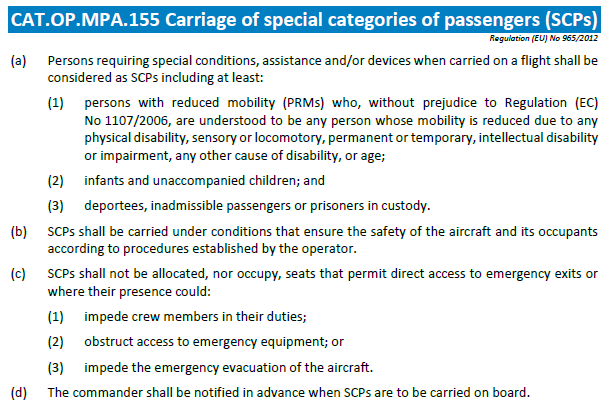Who is an SCP?
References: Regulation (EC) No 1107/2006 is available on EUR-Lex website. Regulation (EU) No 965/2012 and Regulation (EU) 2018/1139 and the study EASA 2008.C.25 are available on EASA website.
SCPs are passengers who, when carried on a flight, require special conditions, assistance and/or devices and their situation needs appropriate attention and adaptation to their particular needs. These passengers shall not be allocated, nor occupy, seats that permit direct access to emergency exits or where their presence could impede crew members in their duties, obstruct access to emergency equipment or impede evacuation of the aircraft.
Under the EU law, aircraft operators are ultimately responsible for the safe operation of the aircraft and for the safety of passengers on board. Regulation (EU) No 965/2012 on air operations mandates the operator (airline) to establish procedures for its air operation. The operator’s procedures, and the operator’s activities overall, are under the oversight of the Competent Authority (CA) of the individual EU Member State. The CA has the necessary powers and allocated responsibilities for the certification and oversight of persons and organisations subject to Regulation (EU) 2018/1139 and its implementing rules.
The EU rule on SCPs states the following:

The rule is complemented by Acceptable Means of Compliance (AMC) and Guidance Material (GM) which address aspects such as the factors the operator should take into account when establishing procedures for carriage of SCPs, information provided to SCPs, conditions for safe carriage of unaccompanied children, a passenger capable of assisting in case of an emergency, seating allocation, etc. The EU provisions are available on EASA website (the link ‘Easy Access Rules for Air Operations’ contains the rule and the AMCs and GMs in one document):
https://www.easa.europa.eu/regulations#regulations-air-operations
The rules for air operations on SCPs have been developed under the EASA rulemaking tasks RMT.0269/0270 involving a rulemaking group. The track of this rulemaking activity is available on EASA website:
Terms of Reference (ToR) MDM.072 (a) & (b) (RMT.0269 & RMT.0270):
https://www.easa.europa.eu/document-library/terms-of-reference-and-group-compositions/tor-mdm072-b-rmt0269-rmt0270
Notice of Proposed Amendment NPA 2014-01
https://www.easa.europa.eu/document-library/rulemaking-subjects/carriage-special-categories-passengers-scps
Comment Response Document CRD 2014-01
https://www.easa.europa.eu/document-library/comment-response-documents/crd-2014-01
ED Decision 2016/004/R
https://www.easa.europa.eu/document-library/agency-decisions/ed-decision-2016004r
Study on Carriage by Air of Special Categories of Passengers (SCPs), EASA 2008.C.25:
https://www.easa.europa.eu/document-library/research-projects/easa2008c25
Additional information
Regulation (EU) 2018/1139 on common rules in the field of civil aviation and establishing a European Union Aviation Safety Agency specifies the mandate entrusted to EASA by the European Parliament and by the Council:
https://eur-lex.europa.eu/legal-content/EN/TXT/?uri=CELEX%3A32018R1139
Regulation (EC) No 1107/2006 of the European Parliament and of the Council contains the European provisions on rights of disabled persons and persons with reduced mobility (PRMs) when travelling by air: https://eur-lex.europa.eu/legal-content/EN/TXT/?uri=LEGISSUM:l24132 . Questions on this regulation should be addressed to the European Commission.
I am tall or have other circumstances. Do I belong to the group of SCPs?
References: Regulation (EC) No 1107/2006 is available on EUR-Lex website. Regulation (EU) No 965/2012 and the study EASA 2008.C.25 are available on EASA website.
Regulation (EC) No 1107/2006 of the European Parliament and of the Council on rights of disabled persons and persons with reduced mobility (PRMs) when travelling by air does not include the height of an individual in the definition of ‘disability or a person with reduced mobility’. Hence, the EU rules on air operations - Regulation (EU) No 965/2012 - do not include a height of an individual (i.e. a tall passenger) in the ‘special categories of passengers (SCPs)’.
Air operators are free to order from an aircraft manufacturer an aircraft cabin/seat configuration they wish, provided that such cabin/seat configuration meets the certification safety requirements. The space between seat rows (so-called ‘seat-pitch’) is a matter of aircraft certification process*. *Questions on aircraft certification matters should be addressed to EASA Certification Directorate.
EASA has conducted a study on Carriage by air of special categories of passengers, reference EASA 2008.C.25, which, amongst others, concludes that aircraft designers must take into account the increasing percentage of tall passengers. https://eur-lex.europa.eu/legal-content/EN/TXT/?uri=CELEX%3A32018R1139
There may be passengers who do not fall into the category specified by the EU regulations on PRMs and SCPs referenced above, however they may have certain individual circumstances where intervention of the air operator or the Competent Authority may be beneficial or required. Most airlines offer various forms of assistance to passengers with certain requirements. For example, persons suffering from certain specific allergies (not necessarily food-related) are not considered disabled and do not fall into the SCP category either. However, passengers with any such circumstances may contact the operator, or the Competent Authority, to seek a solution prior to their travel.